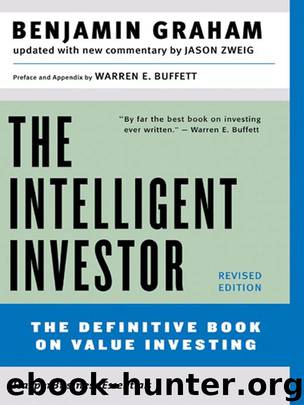The Intelligent Investor, Revised Edition by Benjamin Graham

Author:Benjamin Graham
Language: eng
Format: epub
ISBN: 9780061745171
Publisher: HarperCollins
6. Moderate Price/Earnings Ratio
Current price should not be more than 15 times average earnings of the past three years.
7. Moderate Ratio of Price to Assets
Current price should not be more than 1½ times the book value last reported. However, a multiplier of earnings below 15 could justify a correspondingly higher multiplier of assets. As a rule of thumb we suggest that the product of the multiplier times the ratio of price to book value should not exceed 22.5. (This figure corresponds to 15 times earnings and 1½ times book value. It would admit an issue selling at only 9 times earnings and 2.5 times asset value, etc.)
GENERAL COMMENTS: These requirements are set up especially for the needs and the temperament of defensive investors. They will eliminate the great majority of common stocks as candidates for the portfolio, and in two opposite ways. On the one hand they will exclude companies that are (1) too small, (2) in relatively weak financial condition, (3) with a deficit stigma in their ten-year record, and (4) not having a long history of continuous dividends. Of these tests the most severe under recent financial conditions are those of financial strength. A considerable number of our large and formerly strongly entrenched enterprises have weakened their current ratio or overexpanded their debt, or both, in recent years.
Our last two criteria are exclusive in the opposite direction, by demanding more earnings and more assets per dollar of price than the popular issues will supply. This is by no means the standard viewpoint of financial analysts; in fact most will insist that even conservative investors should be prepared to pay generous prices for stocks of the choice companies. We have expounded our contrary view above; it rests largely on the absence of an adequate factor of safety when too large a portion of the price must depend on ever-increasing earnings in the future. The reader will have to decide this important question for himself—after weighing the arguments on both sides.
We have nonetheless opted for the inclusion of a modest requirement of growth over the past decade. Without it the typical company would show retrogression, at least in terms of profit per dollar of invested capital. There is no reason for the defensive investor to include such companies—though if the price is low enough they could qualify as bargain opportunities.
The suggested maximum figure of 15 times earnings might well result in a typical portfolio with an average multiplier of, say, 12 to 13 times. Note that in February 1972 American Tel. & Tel. sold at 11 times its three-year (and current) earnings, and Standard Oil of California at less than 10 times latest earnings. Our basic recommendation is that the stock portfolio, when acquired, should have an overall earnings/price ratio—the reverse of the P/E ratio—at least as high as the current high-grade bond rate. This would mean a P/E ratio no higher than 13.3 against an AA bond yield of 7.5%.*
Download
This site does not store any files on its server. We only index and link to content provided by other sites. Please contact the content providers to delete copyright contents if any and email us, we'll remove relevant links or contents immediately.
| Analysis & Strategy | Bonds |
| Commodities | Derivatives |
| Futures | Introduction |
| Mutual Funds | Online Trading |
| Options | Portfolio Management |
| Real Estate | Stocks |
Rich Dad Poor Dad by Robert T. Kiyosaki(6399)
Pioneering Portfolio Management by David F. Swensen(6226)
How To Win Friends and Influence People by Dale Carnegie(4441)
The Money Culture by Michael Lewis(4074)
The Dhandho Investor by Mohnish Pabrai(3698)
The Wisdom of Finance by Mihir Desai(3650)
Liar's Poker by Michael Lewis(3367)
Fooled by Randomness: The Hidden Role of Chance in Life and in the Markets by Nassim Nicholas Taleb(3043)
The ONE Thing by Gary Keller(3007)
The Intelligent Investor by Benjamin Graham Jason Zweig(2995)
Mastering Bitcoin: Programming the Open Blockchain by Andreas M. Antonopoulos(2980)
How to Day Trade for a Living: Tools, Tactics, Money Management, Discipline and Trading Psychology by Andrew Aziz(2909)
Rich Dad Poor Dad: What The Rich Teach Their Kids About Money - That The Poor And Middle Class Do Not! by Robert T. Kiyosaki(2907)
Investing For Dummies by Eric Tyson(2893)
How to Win Friends and Influence People by Dale Carnegie(2860)
Market Wizards by Jack D. Schwager(2643)
Zero Hour by Harry S. Dent Jr. & Andrew Pancholi(2614)
How to Pay Zero Taxes, 2018 by Jeff A. Schnepper(2591)
The Psychology of Money by Morgan Housel(2591)
